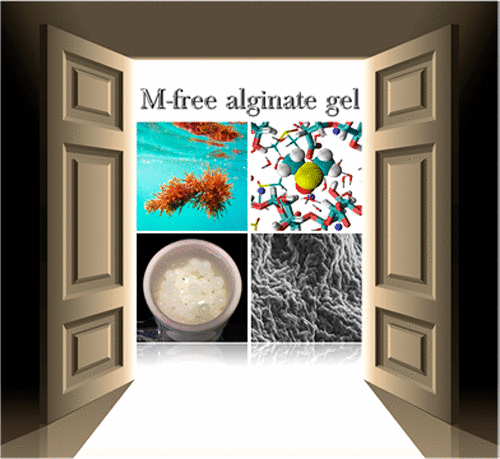当前位置:
X-MOL 学术
›
Biomacromolecules
›
论文详情
Our official English website, www.x-mol.net, welcomes your feedback! (Note: you will need to create a separate account there.)
Paradigm Shift for Preparing Versatile M2+-Free Gels from Unmodified Sodium Alginate
Biomacromolecules ( IF 6.2 ) Pub Date : 2017-08-28 00:00:00 , DOI: 10.1021/acs.biomac.7b00934 Maria M. Pérez-Madrigal 1 , Joan Torras , Jordi Casanovas 2 , Marleen Häring 1 , Carlos Alemán , David Díaz Díaz 1, 3
Biomacromolecules ( IF 6.2 ) Pub Date : 2017-08-28 00:00:00 , DOI: 10.1021/acs.biomac.7b00934 Maria M. Pérez-Madrigal 1 , Joan Torras , Jordi Casanovas 2 , Marleen Häring 1 , Carlos Alemán , David Díaz Díaz 1, 3
Affiliation

|
This manuscript describes a new route to prepare rapidly Ca2+-free hydrogels from unmodified sodium alginate by simply mixing with small organic molecules such as poly(carboxylic acid) compounds as cross-linker agents instead of classical divalent metal salts such as CaCl2. Dimethyl sulfoxide (DMSO) was also found to induce the rapid gelation of aqueous alginate solutions. The gelation process takes place at room temperature, and depending on the composition, gels with good thermal (90–100 °C) and mechanical properties compared to classical metal-containing analogs are obtained. DMSO-based gels showed remarkable self-supporting and thixotropic properties, which can be tuned by the biopolymer concentration. Furthermore, oxalic acid-based gels show superior elasticity than HCl, CaCl2 and DMSO-based gels. The possibility to prepare monoliths, beads, and films of these gels provide them with significant versatility. In particular, films made of alginate and oxalic acid show good potential as synergistic anticancer drug delivery carrier. Computational studies using both quantum mechanical and classical force-field methodologies reveal that hydrogen bonding networks between water and DMSO molecules located close to the alginate chains are responsible for the stability of DMSO-based gels. In contrast, the cohesion of oxalic acid-based gels is a consequence of the coexistence of multiple ionic associations involving oxalate, alginate, and Na+ counterions, which stabilize the system and keep all the interacting species grouped.
中文翻译:

从未经修饰的海藻酸钠制备多功能的不含M 2+的凝胶的范式转变
该手稿描述了一种新方法,该方法可通过简单地与小的有机分子(例如聚羧酸化合物)作为交联剂混合,而不是经典的二价金属盐(例如CaCl 2)与未改性的藻酸钠快速制备不含Ca 2+的水凝胶。还发现二甲基亚砜(DMSO)可以诱导藻酸盐水溶液快速凝胶化。凝胶化过程是在室温下进行的,并且根据组成的不同,可以得到与传统的含金属类似物相比具有良好的热(90–100°C)和机械性能的凝胶。基于DMSO的凝胶显示出显着的自支撑和触变性,可以通过生物聚合物的浓度进行调整。此外,草酸基凝胶显示出比HCl,CaCl更好的弹性2和基于DMSO的凝胶。制备这些凝胶的整料,珠子和薄膜的可能性为它们提供了显着的多功能性。特别地,由藻酸盐和草酸制成的膜显示出作为协同的抗癌药物递送载体的良好潜力。使用量子力学和经典力场方法进行的计算研究表明,水和位于藻酸盐链附近的DMSO分子之间的氢键网络负责DMSO基凝胶的稳定性。相比之下,基于草酸的凝胶的凝聚力是多种离子缔合的结果,这些缔合涉及草酸根,藻酸根和Na +抗衡离子,从而稳定了系统并使所有相互作用的物种保持分组状态。
更新日期:2017-08-29
中文翻译:

从未经修饰的海藻酸钠制备多功能的不含M 2+的凝胶的范式转变
该手稿描述了一种新方法,该方法可通过简单地与小的有机分子(例如聚羧酸化合物)作为交联剂混合,而不是经典的二价金属盐(例如CaCl 2)与未改性的藻酸钠快速制备不含Ca 2+的水凝胶。还发现二甲基亚砜(DMSO)可以诱导藻酸盐水溶液快速凝胶化。凝胶化过程是在室温下进行的,并且根据组成的不同,可以得到与传统的含金属类似物相比具有良好的热(90–100°C)和机械性能的凝胶。基于DMSO的凝胶显示出显着的自支撑和触变性,可以通过生物聚合物的浓度进行调整。此外,草酸基凝胶显示出比HCl,CaCl更好的弹性2和基于DMSO的凝胶。制备这些凝胶的整料,珠子和薄膜的可能性为它们提供了显着的多功能性。特别地,由藻酸盐和草酸制成的膜显示出作为协同的抗癌药物递送载体的良好潜力。使用量子力学和经典力场方法进行的计算研究表明,水和位于藻酸盐链附近的DMSO分子之间的氢键网络负责DMSO基凝胶的稳定性。相比之下,基于草酸的凝胶的凝聚力是多种离子缔合的结果,这些缔合涉及草酸根,藻酸根和Na +抗衡离子,从而稳定了系统并使所有相互作用的物种保持分组状态。



























 京公网安备 11010802027423号
京公网安备 11010802027423号